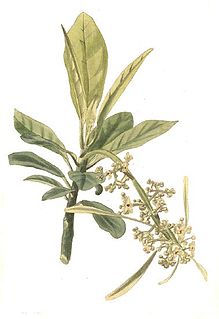
Ricinodendreae is a tribe of the subfamily Crotonoideae, under the family Euphorbiaceae. It comprises 3 genera.
Paracroton is a genus of flowering plants in the Euphorbiaceae first described as a genus in 1859. It is native to South and Southeast Asia, as well as New Guinea.
- Paracroton integrifolius(Airy Shaw) N.P.Balakr. & Chakr. - Kerala, Tamil Nadu
- Paracroton pendulus(Hassk.) Miq. - India, Sri Lanka, Myanmar, Thailand, Malaysia, Borneo, Sumatra, Philippines
- Paracroton sterrhopodus(Airy Shaw) Radcl.-Sm. & Govaerts - W New Guinea
- Paracroton zeylanicus(Müll.Arg.) N.P.Balakr. & Chakr. - Sri Lanka

Omphalea is a plant genus of the family Euphorbiaceae first described as a genus in 1759. It is native to tropical parts of the Americas, the West Indies, Asia, Australia, and Africa.
Lobanilia is a plant genus of the family Euphorbiaceae and the sole genus of the subtribe Lobaniliinae. It was first described as a genus in 1989 and is endemic to Madagascar.
- Lobanilia asterothrixRadcl.-Sm.
- Lobanilia bakeriana(Baill.) Radcl.-Sm.
- Lobanilia claoxyloidesRadcl.-Sm.
- Lobanilia crotonoidesRadcl.-Sm.
- Lobanilia hirtella(Baill.) Radcl.-Sm.
- Lobanilia luteobrunnea(Baker) Radcl.-Sm.
- Lobanilia ovalis(Baill.) Radcl.-Sm.
Claoxylopsis is a plant genus of the family Euphorbiaceae, first described as a genus in 1939. The entire genus is endemic to Madagascar.
- Claoxylopsis andapensisRadcl.-Sm.
- Claoxylopsis perrieriLeandri
- Claoxylopsis purpurascensRadcl.-Sm.
Orfilea is a plant genus of the family Euphorbiaceae first described as a genus in 1858. It is native to Madagascar and other islands in the Indian Ocean.
- Orfilea ankafinensis(Baill.) Radcl.-Sm. & Govaerts - W Madagascar
- Orfilea coriaceaBaill. - Comoros, Madagascar
- Orfilea multispicata(Baill.) G.L.Webster - Madagascar
- Orfilea neraudiana(Baill.) G.L.Webster - Mauritius
Romanoa tamnoides is a species of plant of the family Euphorbiaceae. It is the sole species in the monotypic genus Romanoa, first described in 1824. It is native to Brazil and Paraguay.
Sphaerostylis is a genus of plant of the family Euphorbiaceae first described as a genus in 1858. The entire genus is endemic to Madagascar.
- Sphaerostylis perrieriLeandri
- Sphaerostylis tulasneanaBaill.
Argomuellera is a genus of plant of the family Euphorbiaceae first described as a genus in 1894. It is native to sub-Saharan Africa, Madagascar, and the Comoros Islands.
Droceloncia is a genus of plant of the family Euphorbiaceae first described as a genus in 1959. It contains only one known species, Droceloncia rigidifolia, native to Madagascar and to the nearby island of Mayotte.
Benoistia is a genus of shrubs or trees of the spurge family (Euphorbiaceae) and the monotypic subtribe Benoistiinae. It was first described as a genus in 1939. The entire genus is endemic to Madagascar. It is dioecious.
- Benoistia orientalisRadcl.-Sm. - N + E Madagascar
- Benoistia perrieriH.Perrier & Leandri - Madagascar
- Benoistia sambiranensisH.Perrier & Leandri - N Madagascar
Grossera is a plant genus of the family Euphorbiaceae first described as a genus in 1903. It is native to Madagascar and to mainland tropical Africa. It is dioecious.
- Grossera angustifoliaBarbera&Riina - Equatorial Guinea
- Grossera elongataHutch. - Príncipe
- Grossera glomeratospicataJ.Léonard - East Congo
- Grossera macranthaPax - East Congo, West Congo, Cameroon, Central African Rep.
- Grossera majorPax - Cameroon
- Grossera multinervisJ.Léonard - East Congo, São Tomé
- Grossera paniculataPax - West Congo, Cameroon, Gabon
- Grossera perrieriLeandri - Madagascar
- Grossera vigneiHoyle - Ivory Coast, Ghana, West Congo
Pantadenia is a genus of plants under the family Euphorbiaceae first described as a genus in 1925. It is native to Madagascar and Indochina.
- Pantadenia adenantheraGagnep. - Cambodia, Laos, Thailand, Vietnam
- Pantadenia chauvetiae(Leandri & Capuron) G.L.Webster - Madagascar
- Pantadenia gervaisiiR.Rabev. & McPherson - Madagascar
Cladogelonium is a monotypic plant genus of the family Euphorbiaceae first described as a genus in 1939.
Stachyandra is a plant genus in the family Picrodendraceae first described as a genus in 1990.

Piranhea is a plant genus under the family Picrodendraceae described as a genus in 1866.
Leptonema is a genus of flowering plant belonging to the family Phyllanthaceae first described in 1824. The entire genus is endemic to Madagascar. It is dioecious, with male and female flowers on separate plants.
- Leptonema glabrum(Leandri) Leandri
- Leptonema venosum(Poir.) A.Juss.

Securinega is a genus of plants in the family Phyllanthaceae, first described as a genus in 1789. As presently conceived, the genus is native to Madagascar and the Mascarene Islands in the Indian Ocean. In the past, it was considered to be much more widespread, thus explaining the long list of species formerly included. It is dioecious, with male and female flowers on separate plants.
- Securinega antsingyensisLeandri - W Madagascar
- Securinega capuroniiLeandri - W Madagascar
- Securinega durissimaJ.F.Gmel. - Madagascar, Mauritius, Réunion, Rodrigues Island
- Securinega perrieriLeandri - W Madagascar
- Securinega seyrigiiLeandri - W Madagascar
Lingelsheimia is a plant genus variously classified in the families Putranjivaceae or Phyllanthaceae, first described as a genus in 1909. It is native to central Africa and Madagascar.
- Lingelsheimia abbayesii(Leandri) Radcl.-Sm. - Madagascar
- Lingelsheimia ambigua(Leandri) Radcl.-Sm. - Madagascar
- Lingelsheimia fiherenensis(Leandri) Radcl.-Sm. - Madagascar
- Lingelsheimia frutescensPax - Gabon, Zaire
- Lingelsheimia manongarivensis(Leandri) G.L.Webster - Madagascar
- Lingelsheimia sylvestris(Radcl.-Sm.) Radcl.-Sm. - Tanzania
Sibangea is a plant genus of the family Putranjivaceae, first described as a genus in 1883. It is sometimes included in Drypetes. It is native to central Africa.



